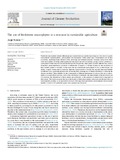Mostrar el registro sencillo del ítem
The use of freshwater macrophytes as a resource in sustainable agriculture
| dc.creator | Poveda Arias, Jorge | es_ES |
| dc.date.accessioned | 2023-02-07T10:58:22Z | |
| dc.date.available | 2023-02-07T10:58:22Z | |
| dc.date.issued | 2022 | |
| dc.identifier.citation | Poveda, J. (2022). The use of freshwater macrophytes as a resource in sustainable agriculture. Journal of Cleaner Production, 369, 133247. https://doi.org/10.1016/j.jclepro.2022.133247 | en |
| dc.identifier.issn | 0959-6526 | |
| dc.identifier.uri | https://hdl.handle.net/2454/44665 | |
| dc.description.abstract | Freshwater macrophytes include different groups of plants that are capable of growing in or very close to aquatic environments (spermatophytes, pteridophytes and bryophytes). These plants play a fundamental role in their ecosystems, regulating biogeochemical cycles, hydrology and sediment dynamic. Currently, many exotic freshwater macrophytes are being anthropogenically introduced into new ecosystems, posing a serious problem as a consequence of their massive and uncontrolled growth. Despite this, these plants can have different uses, such as biomarkers, phytoremediators, producers of metabolites of interest, or biomass formers for the production of feed, biofuels, pellets or ceramics. In this sense, the use of freshwater macrophytes in vivo, as fresh tissues, dry matter, compost, vermicompost, anaerobic digestate, liquid extracts or biochar has reported important benefits in different crops, promoting plant growth, increasing yield, reducing use of chemical fertilizers or reducing the diseases incidence. These benefits are the consequence of different mechanisms of action of the use of macrophytes as an agricultural resource, such as the contribution of nutrients, the improvement of the microbiota and soil structure, the elimination of heavy metals and pollutants, or the presence of antimicrobial compounds in their tissues. This review proposes the use of the biomass of these macrophytes, whose uncontrolled growth is an environmental problem, as an agricultural resource with important agricultural, environmental and economic benefits. A total of 118 published papers were analyzed and discussed. | en |
| dc.description.sponsorship | Grants for the Recualification of the Spanish University System for 2021–2023, Public University of Navarra; Recualification Modality; Funded by the European Union – NextGenerationEU. Open access funding provided by Universidad Pública de Navarra, Spain. | en |
| dc.format.mimetype | application/pdf | en |
| dc.language.iso | eng | en |
| dc.publisher | Elsevier | en |
| dc.relation.ispartof | Journal of Cleaner Production 369 (2022) 133247 | en |
| dc.rights | © 2022 The Author(s). This is an open access article under the CC BY license | en |
| dc.rights.uri | http://creativecommons.org/licenses/by/4.0/ | |
| dc.subject | Eichhornia crassipes | en |
| dc.subject | Macrophytes | en |
| dc.subject | Nutrients | en |
| dc.subject | Organic fertilizer | en |
| dc.subject | Plant growth | en |
| dc.subject | Sustainable agriculture | en |
| dc.title | The use of freshwater macrophytes as a resource in sustainable agriculture | en |
| dc.type | Artículo / Artikulua | es |
| dc.type | info:eu-repo/semantics/article | en |
| dc.date.updated | 2023-02-07T08:48:00Z | |
| dc.contributor.department | Institute for Multidisciplinary Research in Applied Biology - IMAB | es_ES |
| dc.rights.accessRights | Acceso abierto / Sarbide irekia | es |
| dc.rights.accessRights | info:eu-repo/semantics/openAccess | en |
| dc.identifier.doi | 10.1016/j.jclepro.2022.133247 | |
| dc.relation.publisherversion | https://doi.org/10.1016/j.jclepro.2022.133247 | |
| dc.type.version | Versión publicada / Argitaratu den bertsioa | es |
| dc.type.version | info:eu-repo/semantics/publishedVersion | en |
| dc.contributor.funder | Universidad Pública de Navarra / Nafarroako Unibertsitate Publikoa | es |



